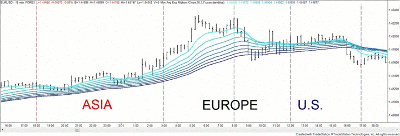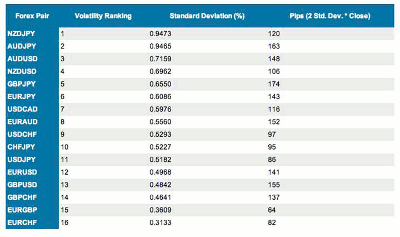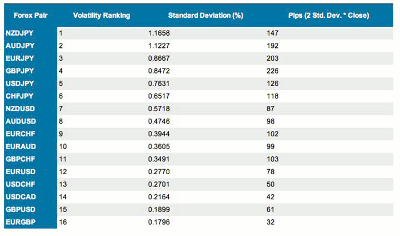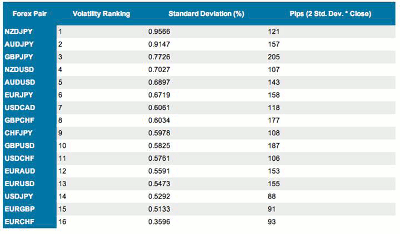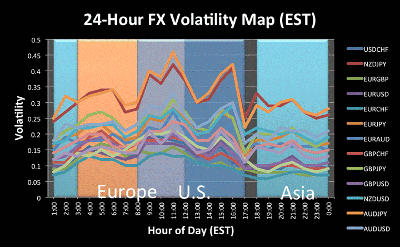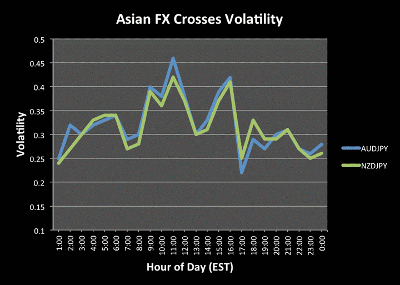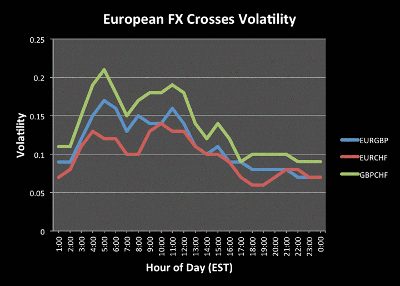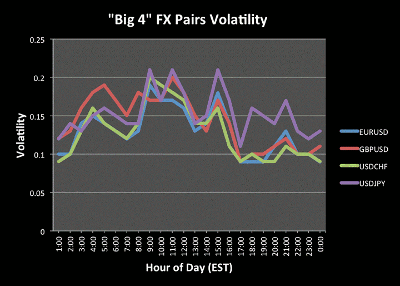Frederic Palmliden of TradeStation and DailyForexTradingEdge.com identifies predictable volatility patterns that affect each of the world’s currencies during the Asian, European, and US trading sessions.
Very much like people, foreign exchange (forex, FX) pairs have unique behaviors and traits that can be observed and studied over time. This may help us to better understand the nature of their price movements.
For instance, volatility in a forex pair, captured by using the standard deviation of price movements in percentage terms, expresses the uniqueness of each pair while revealing the general heartbeat of the FX market.
While shared patterns become apparent, each pair’s volatility shows distinct characteristics that can be utilized by forex traders. Analyzing these findings may not only broaden your knowledge of the forex market, but also improve your trading methodologies.
Chart 1: EUR/USD 15-Minute Chart with Different Trading Sessions
Background
Although the forex market is open 24 hours a day from Sunday evening through Friday evening (US time), the activity in a given pair is not consistent throughout the day. To better understand the intraday structure of the price activity, it is important to note that the forex market is commonly divided into four major daily trading sessions:
- Sydney session (4:00 pm-1:00 am ET, or 16:00-1:00 ET)
- Tokyo session (6:00 pm-3:00 am ET, or 18:00-3:00 ET)
- London session (3:00 am-12:00 pm ET, or 3:00-12:00 ET)
- New York session (8:00 am-5:00 pm ET, or 8:00-17:00 ET)
However, due to the almost complete overlap of the Sydney and Tokyo sessions, it is usually the Tokyo, London, and New York sessions (referred to as the Asian, European, and US sessions) that are the focal points of trading activity.
Volatility Ranking
Before diving deeper into each pair’s unique volatility profile, let’s consider how the different pairs rank against each other within each session in order to create a frame of reference. As a reminder, a simple definition of volatility is the amount of price variation relative to time.
Since this article will focus on price movements in percentage terms, not the price movements valued in a given currency, regular standard deviations will be used instead of other possible methods such as geometric standard deviations (GSD).
The rankings in Tables 1-3 below show the pairs ranked from most to least volatile during the Asian, European, and US sessions. Volatility calculations are made using open-to-close ranges.
Table 1: US Session (8:00-17:00 ET) - Five Years of Data
Table 2: Asian Session (18:00-3:00 ET) - Five Years of Data
Table 3: European Session (3:00-2:00 ET) - Five Years of Data
The ranking would be different if pip values in a given currency (e.g., US dollar) were considered, since one pip in dollars would be different for the EUR/GBP versus that for the NZD/USD at any given time.
For now, let’s assume that trade sizes are adjusted to account for the different pip values to keep the standard deviation values on a level playing field. The “Pips” column in the tables converts the values in the “Standard Deviation” column into expected typical open-to-close ranges for the different sessions. (These tables refer to standard pips, not fractional pips. As a reminder, one standard pip is the fourth digit to the right of the decimal point for most currency pairs and equals ten fractional pips on most trading platforms.)
|pagebreak|Several interesting observations can be made from the different tables. While the volatility fluctuates significantly at times, each forex pair has a tendency to remain in roughly the same position across the different trading sessions, with only a few exceptions, such as the EUR/CHF.
On average, the European session is the most volatile, followed by the US session. The Asian session is the least volatile overall, while having the highest individual volatilities (NZD/JPY and AUD/JPY). It’s important to recognize that the London session is the largest FX market.
The “Pips” amount is displayed to provide an idea of what type of movement can be expected during each session. This amount can be greater for a forex pair ranked lower than another pair due to the different price levels and the way the calculations are being performed.
For example, in the table above, the NZD/JPY ranks above the AUD/JPY, but the pips amount for AUD/JPY is greater than that for the NZD/JPY. This is mainly due to the fact that the overall price level of AUD/JPY was higher than that of NZD/JPY at the end of the study, not because the AUD/JPY is more volatile than the NZD/JPY.
To an FX trader, the information in the different tables can be very useful in choosing which pair to trade depending on one’s particular disposition. For example, someone seeking a lower amount of volatility may want to stay away from the Asian pairs in favor of a European cross currency. Please note, however, that lower volatility in the forex market can relate to high volatility in other asset classes, mainly due to the high leverage.
Now that we have an overall view of these forex pairs, what can be expected within each trading session? Are different times within each session more volatile than others? Are there volatility patterns across the different pairs? Can some pairs be grouped together due to their historical volatilities? To answer these questions, let’s consider a 24-hour volatility map for all these different pairs.
24-Hour Volatility Map
The first graphic leverages the power of TradeStation with Excel to display all forex pairs’ volatility (standard deviations of hourly ranges; highs to lows) during an average 24-hour period over a five-year sample (Figure 1 below). The map refers to US Eastern time, and the three different sessions (Asian, European, and US) are marked using differently colored backgrounds.
Figure 1: 24-Hour FX Volatility
While the overall heartbeat of the FX market is readily visible, the distinctiveness of each pair is just as noticeable. This provides forex traders with a sketch of when volatility rises and falls as the global business day progresses.
The overlap between the European and US sessions provides the greatest volatilities across the board, mainly due to high liquidity and to large investors converting their European assets to US dollar assets in anticipation of the opening of the US market. In the FX market, liquidity means volatility.
The following graphs show that particular forex pairs can be grouped together since their 24-hour volatility maps are very much comparable.
|pagebreak|The first group includes forex pairs where an Asian currency is both the base and quote currency (Asian cross currencies).
The second group includes forex pairs where a European currency is both the base and quote currency (European cross currencies).
The last group includes the “Big 4” from the major currencies. After analyzing the Asian crosses, you may start to wonder if there’s any benefit in trading both the AUD/JPY and the NZD/JPY.
Also, when looking at the European crosses, if you trade the GBP/CHF but are becoming uncomfortable with the volatility, you may want to consider the EUR/CHF instead.
On the other hand, if you are based in the US and looking for a major with some added volatility to trade before going to bed, the USD/JPY may be for you. In addition, if you employ breakout strategies, you may want to stay away when volatility is silent. At the same time, if you prefer using support and resistance levels instead, periods of lower-than-average volatility may be worth focusing on.
Figure 2: Asian Crosses 24-Hour FX Volatility
Figure 3: European Crosses 24-Hour FX Volatility
Figure 4: Big 4 FX Pairs 24-Hour Volatility
For a forex daytrader, it is vital that a particular currency pair has enough movement (volatility) to allow the trader to capture intraday price swings. Adequate liquidity is also needed to avoid excessive slippage.
Trading may be made more efficient by targeting the time of day that most consistently provides the needed amount of volatility and liquidity. Of course, these criteria need to be balanced with your unique profile, which may encompass a wide array of factors including risk tolerance, trading methodologies, experience, current financial situation, and geographic position.
Over time, the successful FX trader will achieve a proper and personal balance of these elements, making FX trading disciplined, productive, and fulfilling.
Part 2 (coming soon) will introduce a custom indicator for forex pairs that utilizes historical volatility to further assist FX traders.
By Frederic Palmliden, CMT, senior quantitative analyst for TradeStation, contributor to DailyForexTradingEdge.com

